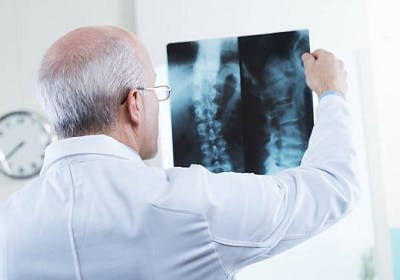No products in the cart.
No products in the cart.
No products in the cart.
No products in the cart.
Home » Neurological Recovery Blog » Spinal Cord Injury » Spinal Cord Surgery: Goals and Recovery Outlook
Last updated on August 10, 2021

The spinal cord is a bundle of nerves that transmits messages between the brain and the rest of the body, including the muscles, organs, and peripheral nerves. Following a spinal cord injury, these signals may become disrupted, resulting in a loss of motor control and sensation. To preserve as much function as possible and prevent the progression of secondary damage, spinal cord surgery may be necessary.
To help you understand what spinal cord surgery entails, this article will guide you through:

In the United States, about 80% of individuals with a spinal cord injury undergo surgery, according to the National Spinal Cord Injury Statistical Center’s 2020 Annual Statistical Report. Depending on the severity of the spinal cord injury, different types of spinal cord surgeries may be recommended.
Generally, the goals of spinal cord surgery include:
These two types of surgeries will help to preserve as much neurological function as possible and prevent the progression of secondary damage. Below, we’ll discuss when each type of surgery is appropriate.
It’s suggested that the most effective treatment for minimizing damage following spinal cord injury is early decompression surgery within 24 hours of injury.
Decompression surgery after spinal cord injury involves removing fragments of vertebrae or any foreign objects that are pressing down on the spinal cord. This helps minimize further tissue damage by relieving pressure off of the nerve roots and minimizing the progression of secondary damage such as inflammation, oxidative stress, and programmed cell deaths.
Commonly performed spinal cord decompression surgeries include:
Your surgeon will determine the most appropriate type of decompression surgery based on the location and severity of your SCI.
Because the spinal column protects the spinal cord, stabilization is essential. It helps ensure that there are no loose particles that might later compress the spinal cord.
Surgery to stabilize the spine after spinal cord injury is called spinal fusion. It involves linking two or more vertebrae together with screws, rods, and bone grafts.
Over time, the bone grafts will promote bone production. This new bone growth will fuse the vertebrae together to stabilize the spinal column long-term.
Now that you understand the various surgeries that may be performed after a spinal cord injury, let’s discuss the controversy regarding the ideal timing of spinal cord surgery.

The debate over the ideal timing for spinal cord injury surgery has been controversial.
The two conflicting views are that:
While more research is necessary to come up with a conclusive statement, it appears that more studies support earlier surgical intervention.
For example, this study compared the effects of early decompression surgery (within the first 8 hours after SCI) with later surgeries. After taking note of functional outcomes throughout the year following the surgery, the early decompression group showed better functional and recovery outcomes.
Ultimately, the timing of surgical management for spinal cord injury will vary case-by-case depending on the severity of the injury and the surgeon’s discretion. Up next, we’ll discuss what to expect after your spinal cord surgery.
After a spinal cord surgery, individuals may feel as if they’re in a completely different body due to loss of sensation and motor control. Rehabilitation after SCI focuses on reteaching the brain, muscles, peripheral nerves, and spinal cord to work in sync again through continuous repetition.
The spinal column can be extremely fragile after surgery, so individuals will likely need to wear a brace for structural support.
Once they are cleared by their physician, individuals should participate in physical and occupational therapy to learn how to adjust and maximize their mobility. Specialists in both types of rehabilitative therapies will evaluate the patient’s functional abilities and create a customized recovery plan.
Physical therapy will focus on developing gross motor function through targeted exercises. In contrast, occupational therapy will focus on improving mobility by practicing activities of daily living. If necessary, an occupational therapist may also teach you how to use adaptive tools to become more independent.
Additionally, your physician may also recommend participating in psychotherapy to help you cope with the emotional effects of life after spinal cord injury. There, you will learn how to effectively address changes in your mental health status, which may help put you in a better headspace for pursuing rehabilitation.
Because every SCI is unique, it’s ideal to seek personalized rehabilitation that caters to your specific lifestyle and concerns.
Generally, spinal cord surgery focuses on decompression of the spinal cord and stabilization of the spine.
While surgery won’t reverse damage to the spinal cord, it can often minimize or prevent further damage from developing.
We hope this article helped you better understand what spinal cord surgery involves and what to expect as you recover.
featured images: iStock/gorodenkoff/cyano66/Natali_Mis

Get instant access to our free exercise ebook for SCI survivors. If you liked this post, you’ll LOVE our emails and ebook.
Each exercise features pictures of a licensed therapist to help guide you. You’ll also receive our popular recovery emails with SCI survivor stories and other useful tips — you can opt out anytime.
We will never sell your email address, and we never spam.


Flint Rehab is the leading global provider of gamified neurorehab tools. Check out our bestselling tool by clicking the button below:
Depending on the severity of your spinal cord injury, there may be hope for improved mobility. Consistent at-home therapy is key to making this happen.
That’s why Flint Rehab created FitMi, a motion-sensing, gamified home recovery tool designed for neurological injury like SCI.
Here’s what others have said about it:
“I purchased this wonderful equipment for the use of spasticity for my right hand. Initially I wasn’t sure if it would work because of the various treatments I tried and also many physiotherapists who tried their level best, but didn’t achieve any positive results.
However after trying FitMi, I could feel that slowly and steadily I am improving. It’s really a great device that minutely takes care of each and every muscle of your affected body part. The biggest plus point is, you can use this device anywhere, anytime with precise exercises that you need and also saves your money and time spent on your physiotherapist.“
— Chandrakiran
FitMi works by encouraging you to practice rehab exercises with high repetition. On average, survivors complete hundreds of repetitions per half hour session.
“Massed practice” like this helps stimulate and rewire the nervous system. While you can achieve massed practice with a written sheet of exercises, it can be tough to stick with it consistently — and consistency is key to recovery.
FitMi helps transform rehab exercises into an engaging, interactive experience. The yellow and blue “pucks” track your movement and provide feedback. All of this comes together for a motivating home therapy program.
A survivor named Tom put it perfectly:
“I believe this device will help me concentrate on making the repetitive actions needed to obtain further movement range in my wrist and hand and arm and therefore rating it with five stars. My occupational therapist recommended to give this a try. I have been using FitMi for just a few weeks. I feel more at ease in flexing.”
If you’d like to learn more about FitMi, click the button below:

Do you have this 15 pages PDF of SCI rehab exercises?
Get a free copy of our ebook Rehab Exercises for Spinal Cord Injury Recovery. Click here to get instant access.
Grab a free rehab exercise ebook!
Sign up to receive a free PDF ebook with recovery exercises for stroke, traumatic brain injury, or spinal cord injury below: